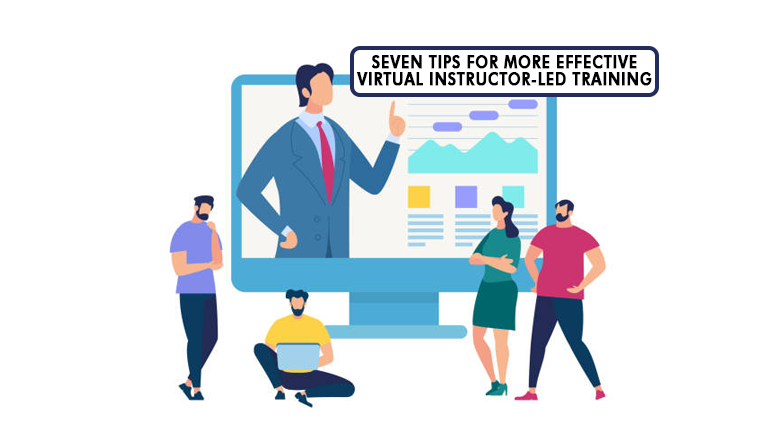Since 2020, online training has been on the rise with surveys reporting that at least 80% of companies have used an e-learning platform to deliver their learning & development programs. According to a recent study by the Training Industry, of the huge number of online training programs conducted, 31% have been in the form of virtual instructor-led training (VILT). So what is virtual instructor-led training exactly? How does it differ from other online training modalities? And how can organizations optimize this form of training for the best results?
If you’re interested in knowing the answers to these questions, keep on reading this article. In this article, we’ll share with you some top tips to follow in order to deliver virtual instructor-led training programs that are as impactful as offline training.
What is Virtual Instructor-Led Training (VILT)?
Virtual instructor-led training is a form of learning program that occurs online. These programs differ from their self-paced counterparts in that they are instructor-led and synchronous. In other words, an instructor delivers the training entirely online using a meeting or learning application such as Zoom, Google Meet, or Blackboard Collaborate. Learners attend the training program from anywhere across the globe simultaneously as it is being delivered.

What is the added value of that? Interaction! Interaction is the single biggest advantage that VILT has over self-paced programs. The face-to-face availability of both the instructor and the learners all at the same time gives room for higher interactivity and knowledge sharing. The question becomes how organizations can leverage this advantage.
Virtual Instructor-Led Training (VILT) in Numbers
● 75% of organizations use virtual classrooms and webcasting for online training.
● 37% of companies’ training portfolios are being offered in virtual and hybrid delivery modalities.
● 69% of learning leaders think that 60% or more of their organization’s instructor-led training will remain virtual.
● Employees learn 70% of their abilities on the job, 20% from their peers and colleagues, and 10% through formal training sessions.
● 32% of learning leaders favor in-person training, as opposed to 16% favoring VILT.
● 36% of senior leaders prefer other learning approaches to VILT.
● Learning leaders describe learners’ distraction as the biggest area for VILT improvement.
● Learning leaders more often cite interactivity and engagement as an area of needed improvement in VILT.
Despite the obvious advantage of VILT, many trainers struggle to make it work due to the lack of upskilling received to adapt their delivery styles to the new learning environment. In fact, many learning & development professionals have not received any sort of upskilling in this new modality before being demanded to design and deliver VILT.
So, how can we turn this around?
Here we introduce to you our top tips to deliver VILT that engages and sticks.
1. Set the rules
One of the big mistakes that VILT instructors do is that they give up the control they have in offline training once the training goes VILT. Instead, make sure you re-iterate the rules that make training work. One of the most important rules to set before the training starts is the ‘camera on’ rule. It is a best practice that learners commit to opening their cameras throughout the VILT program to help them maintain their focus and achieve their learning goals.
2. Do not compromise on instructional design
Sound instructional design is based on the 30%-70% or the 20%-80% rule where the instructor’s speaking time ranges from 20-30% of the training time as opposed to 70-80% from the learners’ side. This is maintained by simply presenting the learning material in the instructors’ speaking time and dedicating the remaining time to active learning activities such as problem-solving, application, role-playing, case study analysis, etc.
However, for some reason, some of the best instructors who follow these rules offline sometimes entirely drop them when they move to the VILT sphere. It is important to think through ways to adapt your existing offline activities to work online so that you can maintain the same healthy speaking time distribution in your VILT programs.

3. Leverage the learning platform
The platforms used for VILT today have increasingly new and extremely useful features that can assist in driving interaction. However, reports show that many of these features go unused. For example, a study by Capterra shows that 32% of organizations have reporting or analytics features in their learning platforms but they go largely unused. To reap the benefits of the technology you are using and boost interactivity, take the time to consult with your provider or the IT department in your company to understand how to use the various features your platform comes with. Most platforms today have handy features such as polls, reactions, screen sharing, whiteboard sharing, breakout rooms, etc.
4. Adapt activities & games
Do not skip the activities and games simply because the training is now online. You can adapt most activities & games to be conducted in VILT format. There are many tools that can help you with this such as Google Jamboard, Miro, Padlet, Quizizz, Mentimeter, Cosmobuzz, SpintheWheel, Kahoot, or even good old Powerpoint. You can even use instructional design software such as Storyline to create shareable simulations that learners can take in the online class with you.

5. Educate on the technology
One of the biggest barriers to leveraging all the tools that can help with VILT is that very often the learners themselves struggle with the technology. In fact, according to OECD, on average, only 5% of adults score at the highest level of digital proficiency in PIAAC while about 15% of adults lack even the most basic computer skills needed to use learning technology. To counterfeit this, create short tutorial videos about all the tools that will be used throughout the training and share them with the learners in due time before the program starts along with the rules. This should give the learners enough time to acquaint themselves with the tools they will use and the rules they are expected to adhere to during the program.
6. Do not compromise on classroom management
A big part of classroom management is managing under and over-participating learners. All effective instructors manage this well offline, but for some reason, they leave this very important skill out the door before they start their VILT program. Remember, VILT does not mean relinquishing control. Therefore, we advise you to continue to invite under-participating learners to answer specific questions and share their opinions, to thank over-participating learners for their contributions, and to take the time to listen to others’ points of view.
7. Manage recordings
Although the ability to catch up on what has been missed through watching class recordings is one of the best advantages that comes with VILT, unfortunately, practice shows that a ‘promise to share recordings’ before the start of a program significantly decreases attendance. Therefore, we advise you to add within the program rules minimum attendance criteria for recording sharing. This will ensure that learners prioritize attendance and resort to recordings only when necessary.
How Can XpertLearning Help?
These were our top tips for delivering more effective virtual instructor-led programs. If you are considering transforming your ILT programs into VILT but need help making the shift, check out our VILT solutions here. Whether you train in-house or bring in external instructors, we can assist you with creating new training programs or transforming your existing Instructor-Led Training programs into a virtual format.

